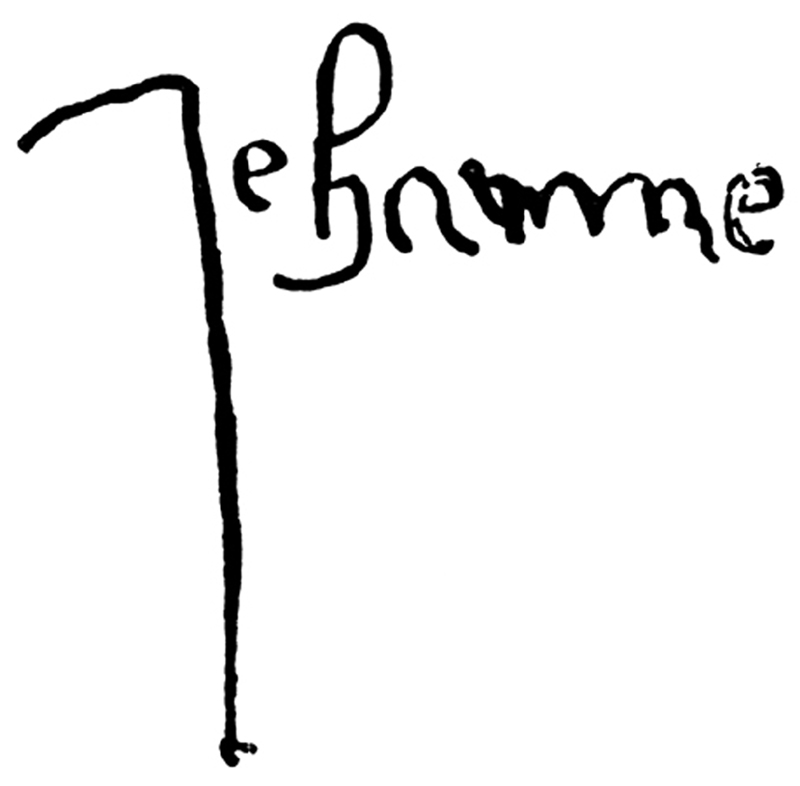
APPENDIX IV
RELICS OF JOAN OF ARC
As a member of the Joan of Arc Center in Orleans, France, I had an opportunity to speak with a staff member concerning Joan's relics. According to this person there are very few definite relics of Joan left to us.
Joan's heart and intestines did not burn despite the two attempts made by the executioner to consume them by the intense flames that he created. The Cardinal of Winchester then ordered him to gather up all of Joan's ashes and remains and cast them into the Seine River, which the executioner did. Because of this there are no first class relics of Joan.
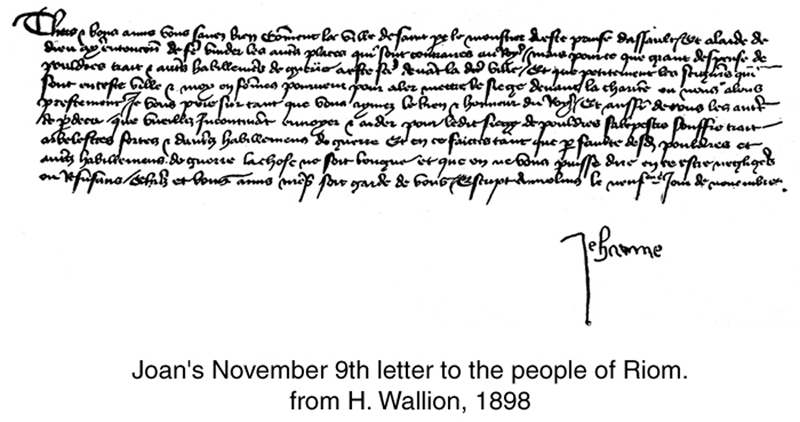
On one of the nine surviving letters dictated by Joan, she had placed one strand of her own hair in the wax seal. This letter went to the citizens of Riom. Deplorably the hair has disappeared sometime during the second half of the nineteenth century. Perhaps it is now in some private collection but whatever happened to it, it is lost to the general public.

Copy of Joan's first known signature from the November 9th letter to the town of Riom.
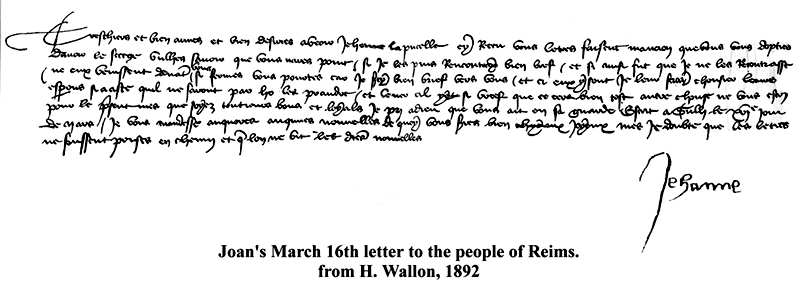
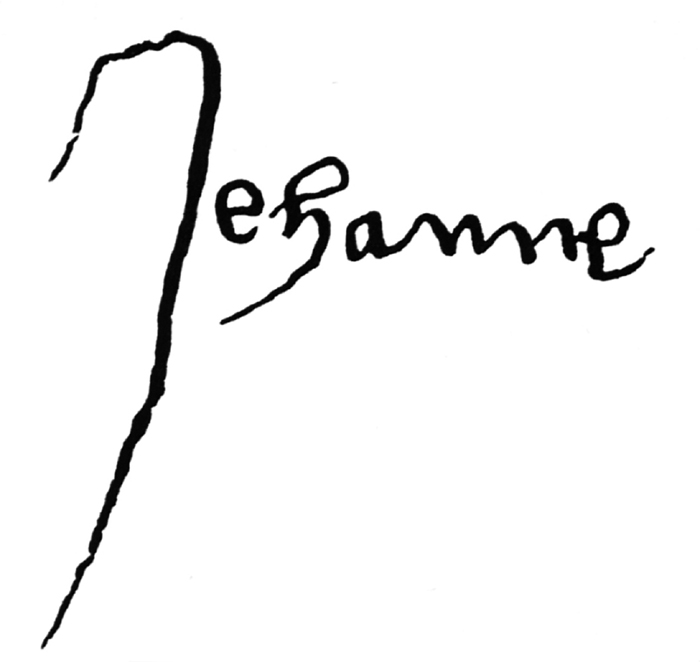
Copy of Joan's second known signature from the March 16th letter to the town of Reims.
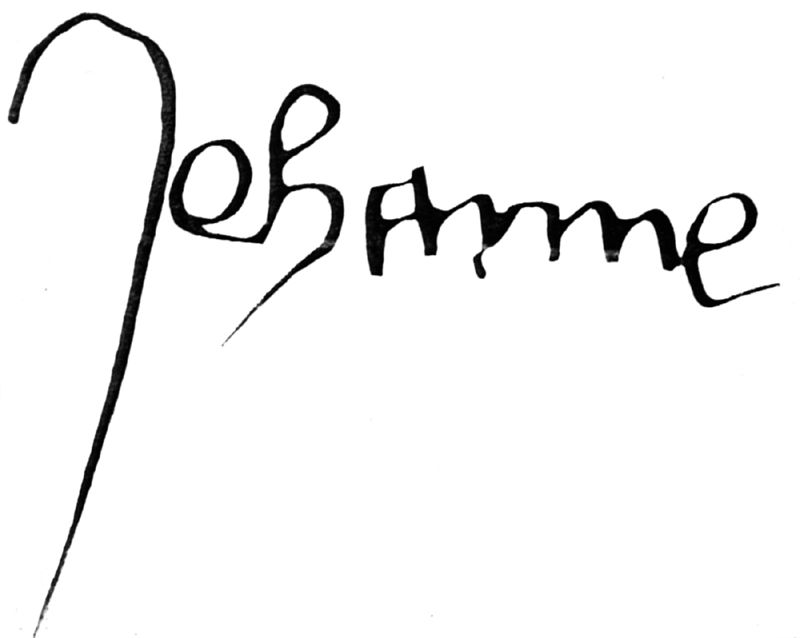
Copy of Joan's third known signature from the March 28th letter to the town of Reims.

Items that were owned and used by a Saint are considered second class relics. During the French Revolution, a time when Anti-God, Anti-Church and Anti-clerical forces ruled the country, several truly authentic relics of Joan were destroyed. Among them was the hat that Joan gave to Charlotte Boucher. Her descendants had kept this hat for some two hundred years until the early 1600's when it was given to the Oratorian Order of Priests. It remained in the Order's Mother House in Orleans until the revolutionaries took the hat and threw it into a bonfire in 1792.
The descendants of Joan's brother, Pierre, had in their possession three of her letters and a sword that she had worn. The letters were saved but Joan's sword was lost during the chaos of the revolutionary period.
Finally, during the height of the French Revolution Joan's standard was burned. The staff person explained that it really was not the original standard that was burned. She explained that during the three hundred plus years that the town held the standard, the standard's cloth was continually being repaired and pieces of it were replaced due to the damage done by moths. Even so, it just shows what hate had infected these people's hearts for them to want to destroy the relics of their own heroine.
The ring that was given to Joan by her mother and father was taken from her at the time of her capture. It was handed over to Bishop Cauchon who in turn gave it to Cardinal Beaufort, the Bishop of Winchester, England. The Beaufort family claimed that they had handed this very ring down within the family for generations. The ring in question is described as having the initials IHS and MAR with only one cross. However, its authenticity is highly doubted because it does not match Joan's description of her ring, which she gave during her trial, 'It had three crosses on it with the names of Jesus and Mary.' The ring is now in the hands of a private collector.
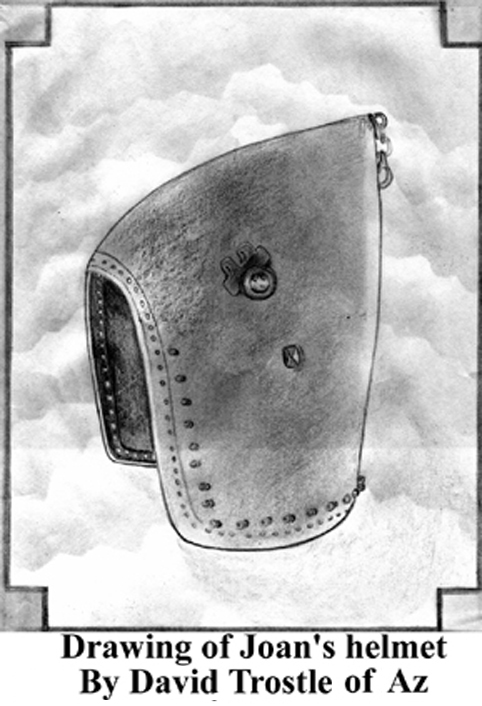
After World War II a helmet that might have belonged to Joan was obtained by the New York Metropolitan Museum of Art. The helmet hung over the high altar of the Church of Saint Pierre du Martroi in the City of Orleans and it is believed that it was a votive offering given by Joan for the healing of the wound that she received at the Tourelles. The museum now displays this helmet as part of its armor collection. But again there is no way of definitely proving that Joan wore the helmet in question.
The staff person told me that the historians have no idea what happened to the sword of Saint Catherine.

"The Museum of Dijon" had a sword, which may have belonged to Joan but its authenticity is questionable. The blade seems to have been made in the 1490's but the hilt is small enough to fit a woman's hand. Therefore the hilt may be authentic but the blade definitely wasn't. ("The Museum of Dijon" no longer exists and the whereabouts of this sword is not known.)
A third class relic is something touched by the Saint. There are many such relics scattered throughout France. Included in this group are the nine letters that Joan dictated. They were addressed to the English at Orleans, the Duke of Burgundy, the Count d' Armagnac, the Hussites, to the citizens of Riom and Troyes and three to the citizens of Reims. Three of these letters bear her signature. Her first signature is found on the letter to the citizens of Riom. The other two letters that bear her signature are addressed to the citizens of Reims.
The Church of Saint Remy in Domremy has three such relics, the holy water fountain, and the baptismal fountain as well as the Statue of Saint Margaret.
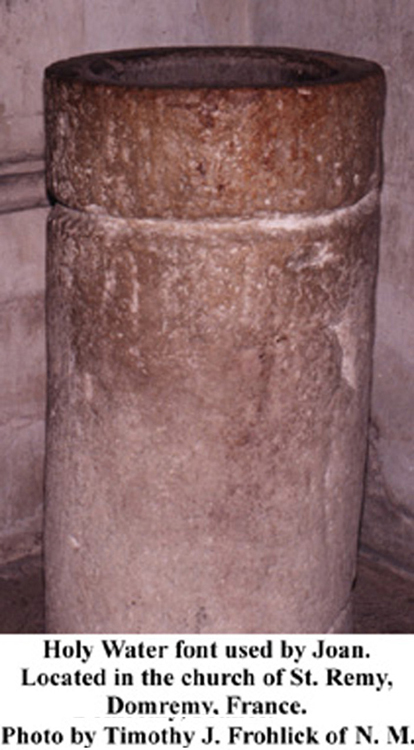
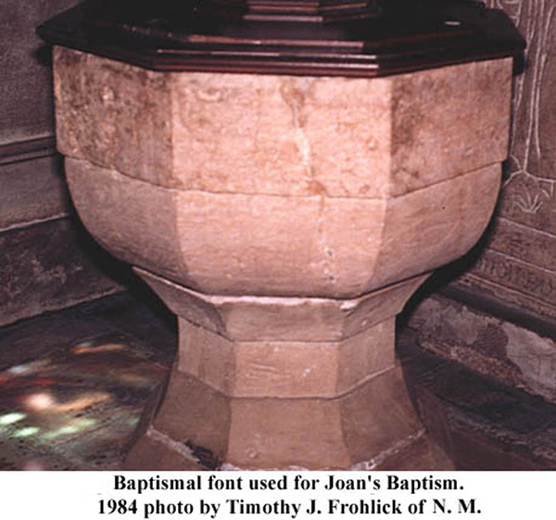
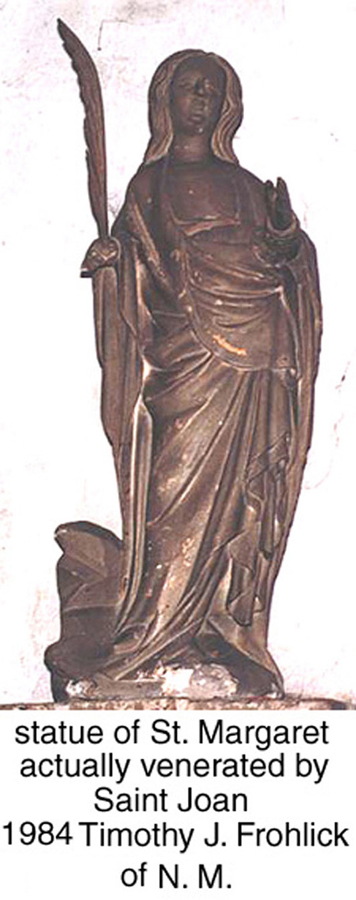
In the Basilica of Saint Joan of Arc at the Bois Chenu, there is the Statue of Our Lady of Bermont before which Joan prayed every Saturday.
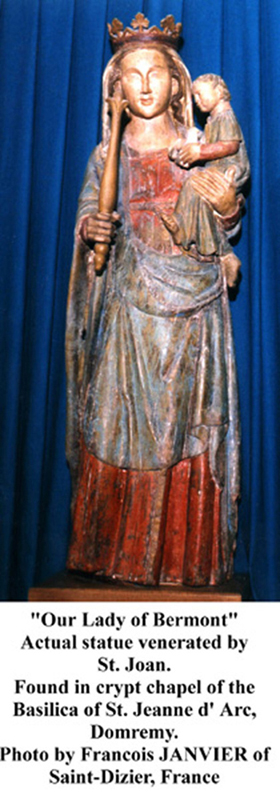
At Vaucouleurs, in the church crypt of De Baudricourt's castle, there is a statue called 'Our Lady of the Vaults.' Joan often prayed before this statue while she waited for Sir Robert to give her permission to leave for Chinon.
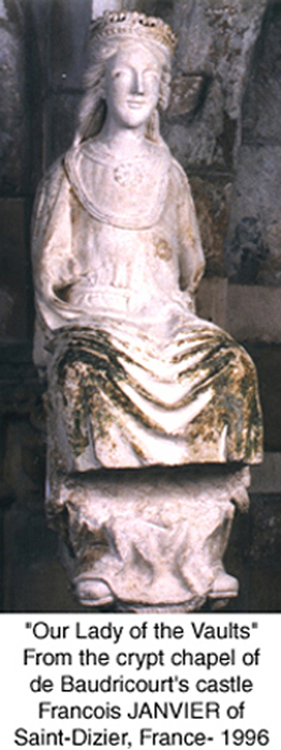
In the town's museum there is an ancient crucifix called 'The Christ of Septfonds,' which came from the Church of Saint Nicolas-de-Septfonds. Joan prayed before this crucifix.
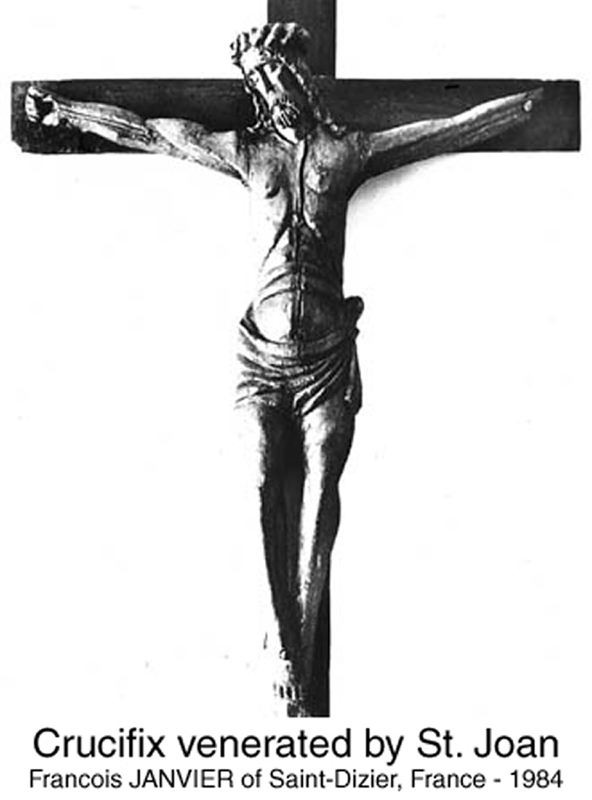
Here also near the Gate of France stands an ancient and enormous lime tree, to which tradition says Joan tied her horse while making last minute preparations for her departure.
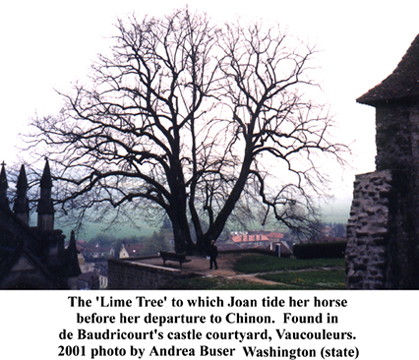
In the chapel shrine of Saint Catherine-de-Fierbois, there is the Statue of Saint Catherine, in front of which Joan prayed.

Joan used this stone to help her mount her horse when she was leaving the town of Poitiers.
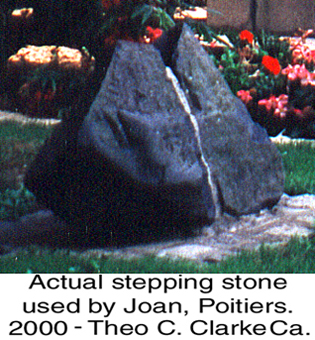
Joan venerated this statue of "Our Lady of Miracles" while she was in Orleans. This statue is located in the Church of St. Paul - Orleans, France.
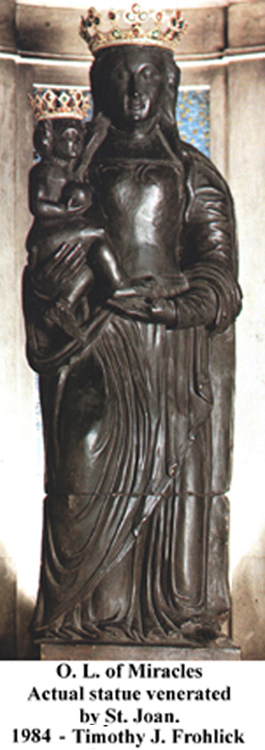
In the town of Saint-Pierre-le-Moutier's church there is an ancient stone Statue of Saint Michael, which Joan knelt and prayed before.
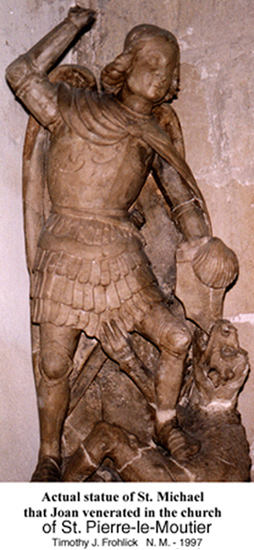
In the town of Lagny, where the child was restored to life, there is a statue of the Blessed mother called 'Our Lady of Good Help.' It was before this image that the dead child was laid and Joan and the town's girls prayed.
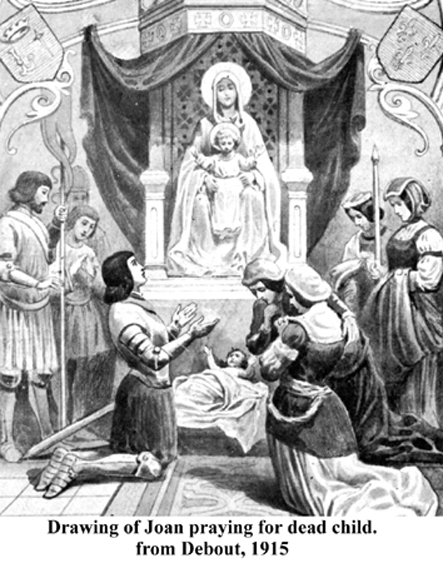
In Compiègne's Church of Saint Jacques, just prior to her capture, Joan heard Mass and received Holy Communion after which she knelt and prayed before a stone Statue of the Madonna and Child.
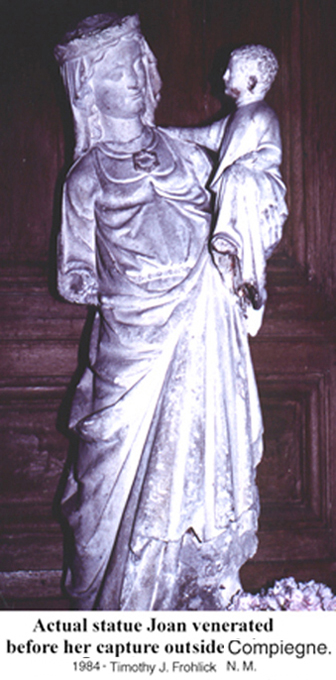
I asked where Joan's father, mother and brothers were buried. I was told that their burial sites were unknown.
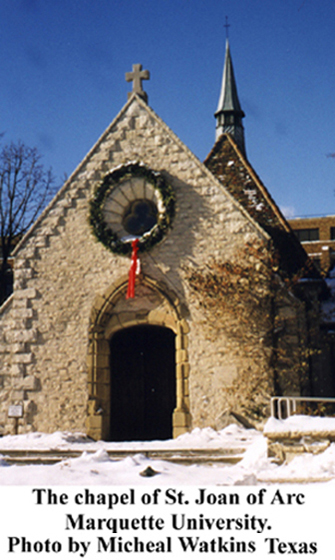
There is a very slight possibility that Marquette University, of Milwaukee, Wisconsin has a relic of St. Joan. The St. Joan of Arc chapel, which is located on the campus, came from the French town of Chasse. This town is a few miles south of Lyon, France. It is important to note that Joan was NEVER anywhere near the town of Lyon, which at the time was deep within Burgundian territory.
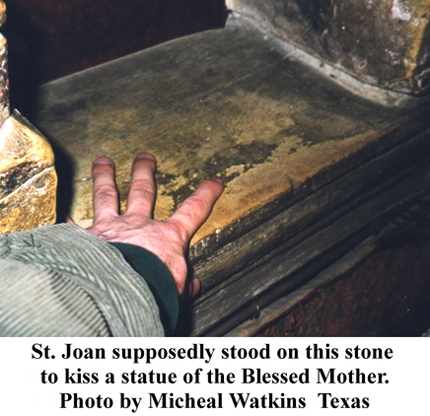
I spoke with the caretaker of this Chapel. She told me that they have no information as to where the so-called, "stepping stone of Joan of Arc" came from. This stone was NOT part of the original structure that came from Chasse, France. All that can be said about this stone is that it is believed St. Joan stood on it to venerate a statue of the Blessed Mother. What makes this stone so unusual is that it is always COLDER than the surrounding stones whatever the time of year.
On September 17th, 2001 Mr. Lawrence DiPrima of IL. went to the Saint Joan of Arc Chapel at the Marquette University, Wis. He brought with him a "Heat Gun", which measures temperature differences. A "Heat Gun" does not touch the surface to be measured.
I will allow him to tell you his story in his own words.
"I was refused by the curator, saying that we should act on faith alone. Funny, The Church let the scientific community to examine The Shroud of Turin, and I truly believe it is the burial cloth of Christ."
"I was at the Chapel on 17th Sept. 2001, the temperature in Milwaukee was between 60 to 70 degrees Fahrenheit with an overcast sky. The interior of the Chapel was cold and gloomy."
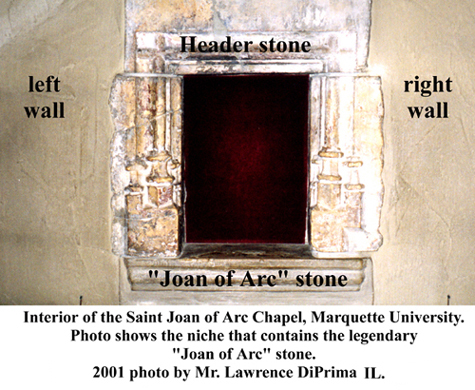
"The procedure is to put your hand on top of the alleged "Joan of Arc" stone and place your other hand on the surrounding area. The stone was definitively colder when I touched the right and left wall."
"After rubbing both hands on my pants to equalize them I touched the "Joan of Arc" stone and the header stone. This is when my lack of faith kicked in or is it really a stone touched by St. Joan."
"The header, to me anyway, was the same or even colder than the "Joan of Arc" stone. The let-down was measurable."
"I have tried to be fair in my judgement of this stone. Other people may have different views, I would love to hear them."